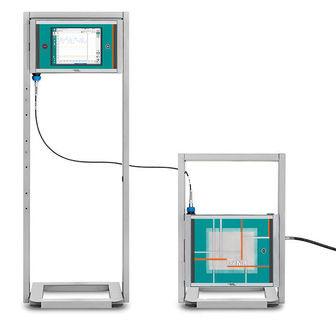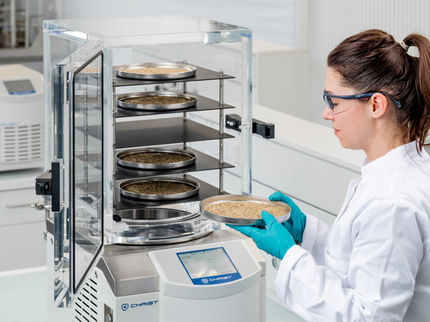To use all functions of this page, please activate cookies in your browser.
my.bionity.com
With an accout for my.bionity.com you can always see everything at a glance – and you can configure your own website and individual newsletter.
- My watch list
- My saved searches
- My saved topics
- My newsletter
Equilibrium unfolding
In biochemistry, equilibrium unfolding is the process of unfolding a protein or RNA molecule by gradually changing its solution conditions, i.e., its environment. Since equilibrium is maintained at all steps, the process is reversible (equilibrium folding). Equilibrium unfolding is used to determine the conformational stability of the molecule. Product highlight
Theoretical backgroundIn its simplest form, equilibrium unfolding assumes that the molecule may belong to only two thermodynamic states, the folded state (typically denoted N for "native" state) and the unfolded state (typically denoted U). This "all-or-none" model of protein folding was first proposed by Tim Anson (1945), but is believed to hold only for small, single structural domains of proteins (Jackson, 1998); larger domains and multi-domain proteins often exhibit intermediate states. As usual in statistical mechanics, these states correspond to ensembles of molecular conformations, not just one conformation. The molecule may transition between the native and unfolded states according to a simple kinetic model with rate constants kf and ku for the folding (
where R is the gas constant and T is the absolute temperature in kelvins. Thus, ΔG is positive if the unfolded state is less stable (i.e., disfavored) relative to the native state. The most direct way to measure the conformational stability ΔG of a molecule with two-state folding is to measure its kinetic rate constants kf and ku under the solution conditions of interest. However, since protein folding is typically completed in milliseconds, such measurements can be difficult to perform, usually requiring expensive stopped-flow or (more recently) continuous-flow mixers to provoke folding with a high time resolution. Chemical denaturationIn the less expensive technique of equilibrium unfolding, the fractions of folded and unfolded molecules (denoted as pN and pU, respectively) are measured as the solution conditions are gradually changed from those favoring the native state to those favoring the unfolded state, e.g., by adding a denaturant such as guanidinium hydrochloride or urea. (In equilibrium folding, the reverse process is carried out.) Given that the fractions must sum to one and their ratio must be given by the Boltzmann factor, we have Protein stabilities are typically found to vary linearly with the denaturant concentration. A number of models have been proposed to explain this observation prominent among them being the denaturant binding model, solvent-exchange model (both by Schellman, JA[1]) and the Linear Energy Model (LEM; Pace, NC[2]). All of the models assume that only two thermodynamic states are populated/de-populated upon denaturation. They could be extended to interpret more complicated reaction schemes. The denaturant binding model assumes that there are specific but independent sites on the protein molecule (folded or unfolded) to which the denaturant binds with an effective (average) binding constant k. The equilibrium shifts towards the unfolded state at high denaturant concentrations as it has more binding sites for the denaturant relative to the folded state (Δn). In other words, the increased number of potential sites exposed in the unfolded state is seen as the reason for denaturation transitions. An elementary treatment results in the following functional form: where ΔGw is the stability of the protein in water and [D] is the denaturant concentration. Thus the analysis of denaturation data with this model requires 7 parameters: ΔGw,Δn, k, and the slopes and intercepts of the folded and unfolded state baselines. The solvent exchange model (also called the ‘weak binding model’ or ‘selective solvation’) of Schellman invokes the idea of an equilibrium between the water molecules bound to independent sites on protein and the denaturant molecules in solution. It has the form: where K is the equilibrium constant for the exchange reaction and Xd is the mole-fraction of the denaturant in solution. This model tries to answer the question of whether the denaturant molecules actually bind to the protein or they seem to be bound just because denaturants occupy about 20-30 % of the total solution volume at high concentrations used in experiments, i.e. non-specific effects – and hence the term ‘weak binding’. As in the denaturant-binding model, fitting to this model also requires 7 parameters. One common theme obtained from both these models is that the binding constants (in the molar scale) for urea and guanidinium hydrochloride are small: ~ 0.2 M − 1 for urea and 0.6 M − 1 for GuHCl. Intuitively, the difference in the number of binding sites between the folded and unfolded states is directly proportional to the differences in the accessible surface area. This forms the basis for the LEM which assumes a simple linear dependence of stability on the denaturant concentration. The resulting slope of the plot of stability versus the denaturant concentration is called the m-value. In pure mathematical terms, m-value is the derivative of the change in stabilization free energy upon the addition of denaturant. However, a strong correlation between the accessible surface area (ASA) exposed upon unfolding, i.e. difference in the ASA between the unfolded and folded state of the studied protein (dASA), and the m-value has been documented by Pace and co-workers. In view of this observation, the m-values are typically interpreted as being proportional to the dASA. There is no physical basis for the LEM and is purely empirical, though it is widely used in interpreting solvent-denaturation data. It has the general form: where the slope m is called the "m-value"(> 0 for the above definition) and In practice, the observed experimental data at different denaturant concentrations are fit to a two-state model with this functional form for ΔG, together with linear baselines for the folded and unfolded states. The m and Structural probesUnfortunately, the probabilities pN and pU cannot be measured directly. Instead, we assay the relative population of folded molecules using various structural probes, e.g., absorbance at 287 nm (which reports on the solvent exposure of tryptophan and tyrosine), far-ultraviolet circular dichroism (180-250 nm, which reports on the secondary structure of the protein backbone) and near-ultraviolet fluorescence (which reports on changes in the environment of tryptophan and tyrosine). However, nearly any probe of folded structure will work; since the measurement is taken at equilibrium, there is no need for high time resolution. Thus, measurements can be made of NMR chemical shifts, intrinsic viscosity, solvent exposure (chemical reactivity) of side chains such as cysteine, backbone exposure to proteases, and various hydrodynamic measurements. To convert these observations into the probabilities pN and pU, one generally assumes that the observable A adopts one of two values, AN or AU, corresponding to the native or unfolded state, respectively. Hence, the observed value equals the linear sum
By fitting the observations of A under various solution conditions to this functional form, one can estimate AN and AU, as well as the parameters of ΔG. The fitting variables AN and AU are sometimes allowed to vary linearly with the solution conditions, e.g., temperature or denaturant concentration, when the asymptotes of A are observed to vary linearly under strongly folding or strongly unfolding conditions. Thermal denaturationAssuming a two state denaturation as stated above, one can derive the fundamental thermodynamic parameters namely, ΔH, ΔS and ΔG provided one has knowledge on the ΔCp of the system under investigation. The thermodynamic observables of denaturation can be described by the following equations:
→
→
→ → where Determining the heat capacity of proteinsIn principle one can calculate all the above thermodynamic observables above from a single differential scanning calorimetry thermogram of the system assuming that the Alternatively, the
For proteins that have a known 3d structure, the
where the subscripts polar, non-polar and aromatic indicate the parts of the 20 naturally occurring amino acids. Finally for proteins there is a linear correlation between
Assessing two-state unfoldingFurthermore, one can assess whether the folding proceeds according to a two-state unfolding as described above. The can be done with differential scanning calorimetry by comparing the calorimetric enthalpy of denaturation i.e. the area under the peak,
at
When a two-state unfolding is observed the Other forms of denaturationAnalogous functional forms are possible for denaturation by pressure, pH, etc. References
|
||||||||||||||||||||||||||||||||||||||||||||||||
| This article is licensed under the GNU Free Documentation License. It uses material from the Wikipedia article "Equilibrium_unfolding". A list of authors is available in Wikipedia. | ||||||||||||||||||||||||||||||||||||||||||||||||







 ) and unfolding (
) and unfolding ( ) reactions, respectively. The dimensionless equilibrium constant
) reactions, respectively. The dimensionless equilibrium constant ![K_{eq} \ \stackrel{\mathrm{def}}{=}\ \frac{k_{u}}{k_{f}} = \frac{\left[ U \right]_{eq}}{\left[ N \right]_{eq}}](images/math/d/4/d/d4ddc055c1eee29362b5bcdb3e350015.png) can be used to determine the conformational stability
can be used to determine the conformational stability 

![\Delta G = \Delta G_{w} - RT \Delta n \ln \left(1 + k [D] \right)](images/math/1/7/5/1752041895f3662279d5ae080eb82958.png)

![\Delta G = m \left( [D]_{1/2} - [D] \right)](images/math/e/6/7/e67898bc4f47116ce38ebc5e769db564.png)
![\left[ D \right]_{1/2}](images/math/2/e/4/2e42e89fcff9c1bc2b36420b025890ef.png) (also called Cm) represents the denaturant concentration at which 50% of the molecules are folded (the
(also called Cm) represents the denaturant concentration at which 50% of the molecules are folded (the 
![\ \Delta H(T)=\Delta H(T_d)+ \Delta C_p[T-T_d]](images/math/1/1/6/116ccc5a7de4f3802806a4109d69b6b4.png)




![\ \Delta G(T)=\Delta H(T_d)(1-\frac{T}{T_d}) - \Delta C_p[T_d -T +Tln(\frac{T}{T_d})]](images/math/9/8/f/98fde3aa9aa0a90a4bd06335b4837c26.png)
 ,
,  and
and  indicate the enthalpy,entropy and Gibbs free energy of unfolding under a constant pH and pressure. The temperature,
indicate the enthalpy,entropy and Gibbs free energy of unfolding under a constant pH and pressure. The temperature,  is varied to probe the thermal stability of the system and
is varied to probe the thermal stability of the system and  is the temperature at which half of the molecules in the system are unfolded. The last equation is known as the Gibbs-Helmholtz equation.
is the temperature at which half of the molecules in the system are unfolded. The last equation is known as the Gibbs-Helmholtz equation.
 is independent of the temperature. However, it is difficult to obtain accurate values for
is independent of the temperature. However, it is difficult to obtain accurate values for  vs.
vs.  or protein concentration. The slope of the linear fit is equal to the
or protein concentration. The slope of the linear fit is equal to the 
 can be calculated through computer programs such as Deepview (also known as swiss PDB viewer. The ASA_{unfolded} can be calculated from tabulated values of each amino acid through the semi-empirical equation:
can be calculated through computer programs such as Deepview (also known as swiss PDB viewer. The ASA_{unfolded} can be calculated from tabulated values of each amino acid through the semi-empirical equation:

 and
and 
 to the van 't Hoff enthalpy described as follows:
to the van 't Hoff enthalpy described as follows:

 the
the  can be described as:
can be described as:

 .
.


